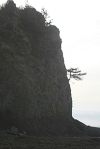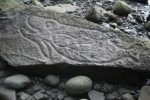The Ozette to Pacific Coast triangle has got to be one of the most beautiful day hikes on the Olympic Peninsula. We picked a rare day in February near the full moon when the tides were at extreme lows and highs and the weather relatively balmy (and on a weekend, no less!). We would be hitting the coast at an outgoing tide, and although both extremes have their advantages, walking the beach at high tide can require taking overland routes to avoid being crashed into cliffs or sucked out to sea. It is good to check the tide charts.
For those who have not been there, the trail starts at the Lake Ozette ranger station. The north fork is approximately 3 miles to Cape Alava, the south is 3 miles to Sandpoint, and they are connected by 3 miles of ocean beaches. Both routes follow a sometimes slippery, cedar-plank boardwalk over bog and rivulets, bordered by ferns, salal, and towering cedars and spruce. To look up at these trees is dizzying; three adults cannot reach around their trunks; you get a glimpse of how the cedars played such an important role in Native American life.
You emerge from the deep, dark woods, to a brilliant oceanscape that extends beyond the curve of the earth.
Dotting the landscape are sea stacks, at high tide surrounded by crashing surf and at low tide by tidepools, each a small universe of sea life. With hardly a soul around, we had the beach mostly to ourselves to share with eagles, kingfishers, gulls, sanderlings, oystercatchers, and the cormorants airing their wings in the afternoon sun. I have seen whales, seals, and sea lions from this beach, but not on this particular occasion. We were wishing we had brought our tent and bags to be able to watch the changing sky and listen to the surf through the night; however, we had to keep up our pace to be able to make the entire 9 miles before dark.
The highlight of our trip was finding some of the Makah petroglyphs. Located about midway down the beach is a cluster of rocks near the shore called the “wedding rocks,” and on the face of some of these are carvings chiseled an estimated 300-500 years ago. There are, I am told, over 40 different carvings. Surprisingly, one is on a rather large, flat sandstone rock just laying on the beach. I somehow expected them to be higher up, further out to sea.
To stumble upon them is to suddenly be hit with the sacredness of this place and with the realization that we are intruders in another’s home. People lived here for thousands of years. They faced storms, torrential rains, and a mudslide that tragically wiped out an entire village. They survived by skill, wit, and strength. They had families, they helped one another, they honored their elders. Who were these artists? What was it like to live in their time? What can we learn from them?
Regardless of how you feel about whale hunting, these petroglyphs are graphic evidence that whales, seals, sea lions, eagles – the sea in all its vengeance and glory – the sun and the moon – and the stories that bound them all together – were the breath and life of these early people. With a spirituality shaped by nature, whales were revered, a part of their culture, and a key to their survival. After all this time, these ancient peoples still speak to us.
And today – and any day like today – white folks like me are merely visitors. Let us not forget that.
February is my favorite time to hike the Ozette triangle, to scavenge beach glass and Olivella shells among the multicolored stones, to scramble over logs and jump the rocks between tidepools, to smell the salty air and listen to the breathing of the ocean, to come to the end of the earth and reconnect with that which is timeless.











Hi Blythe Outstanding! Just came across your blog a few days ago. If your web site stats peak don’t worry. mark
By: mark peterson on February 9, 2009
at 10:35 pm
Hey Mark – Thanks for visiting! It’s hard to find time to post about some of the fun trips we take. It’s easier to find time (or an excuse) to take a hike!
By: blythelight on February 10, 2009
at 5:43 pm
Ver interesting. Please peruse my web site regarding African Black Oystercatchers. You seem to also have a beuatiful hiking trail. Where is it?
By: Fred Orban on February 10, 2009
at 5:47 am
All I can say is WOW. The Oyster Catcher Trail in South Africa looks like an amazing place! I would love to visit! http://www.oystercatchertrail.co.za/
You can see a picture of one of our black oystercatchers on my previous post about paddling with seals.
The Ozette Triangle trail is located near the very far northwest corner of the contiguous United States, specifically, on the Olympic Peninsula of Washington State (about 150 miles west of Seattle). It is within the Olympic National Park.
Thanks for visiting my site!
By: blythelight on February 10, 2009
at 6:00 pm